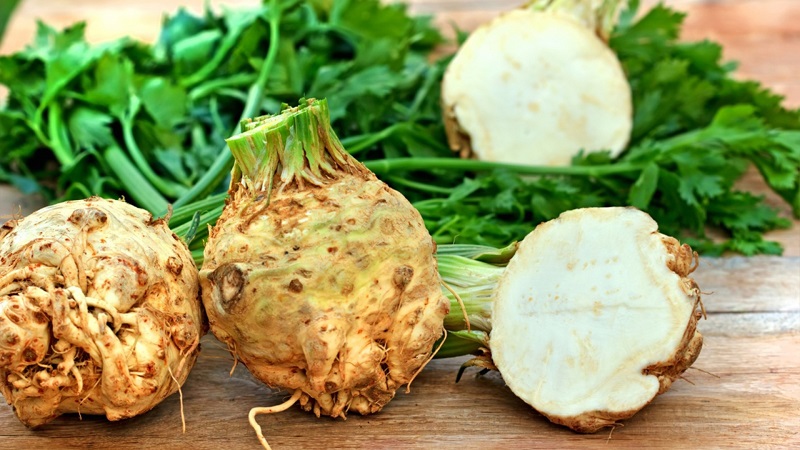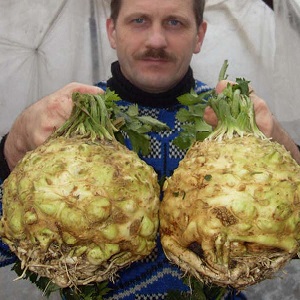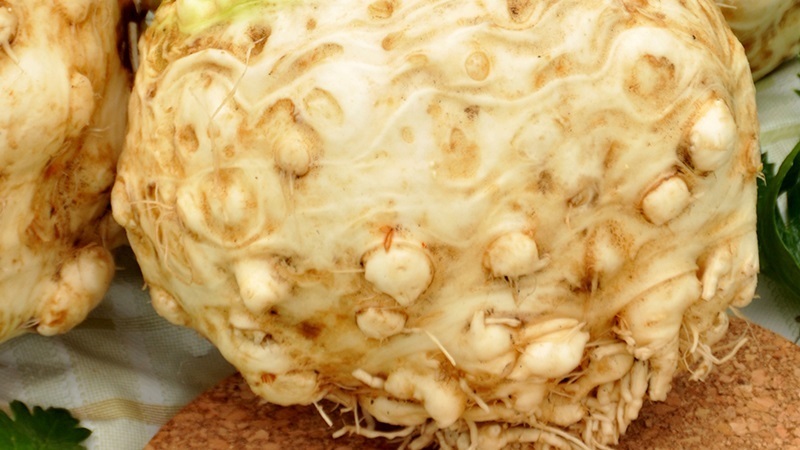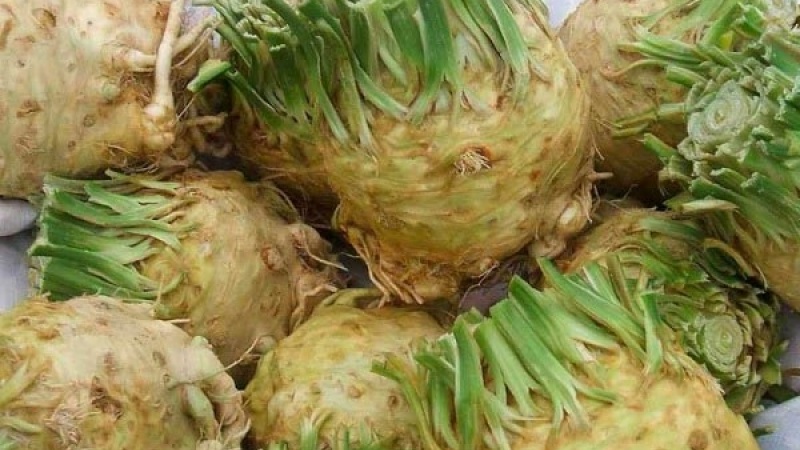Review of the best varieties of root celery
Root celery is especially appreciated for its taste, it is known for its rich vitamin composition, it is used as a medicine in folk medicine. Read about the best varieties of this plant below.
The content of the article
Variety of Root Celery Varieties
Root celery varieties are varied and differ in such characteristics:
- Early maturity... Depending on the timing of ripening, plants are divided into early, mid and late ripening.
- Keeping quality... Mid-season and late-season varieties are well stored in winter. The early ones are mostly intended for fresh consumption.
- The presence or absence of lateral roots... Lateral roots interfere with the development of the main root to the fullest, taking away nutrients. Vegetable growers struggle with them by unloading, raking off a third of the soil and removing bare secondary roots. Also, the lateral roots are cut off during their formation. Most varieties are characterized by the presence of a small number of adventitious roots or their complete absence. A variety with many adventitious roots - Apple.
- Root size... The size of a vegetable of the same variety may vary. In many ways, it depends on the conditions: planting density, feeding and care. The largest root crops are recorded in such varieties as the Prague giant (root crop up to 3-3.5 kg), Diamant (fruits grow up to 3.5 kg), President (up to 2-2.5 kg), Russian size (2.5 -3 kg).

Description and characteristics of the best varieties of root celery
The most popular classification of varieties of root celery according to the ripening time.
Early ripe
Celery of early ripening varieties requires 120 to 150 days for ripening.
Important! Depending on the weather conditions of each season, this time may decrease and increase.
Early varieties are mainly grown for fresh use - in salads, first and meat dishes - and for freezing, drying, canning. These varieties are not suitable for fresh winter storage - the roots quickly begin to deteriorate, the peel wrinkles, the pulp loses its juiciness.
Prague giant
 The growing season is 120-150 days.
The growing season is 120-150 days.
The root shape resembles a turnip... Its average weight is within 200-500 g, some specimens can reach 3 kg.
The pulp is light beige, fragrant, juicy, filled with useful substances, has a delicate taste.
Productivity - up to 4 kg per 1 sq. m.
Almost no adventitious roots.
The Prague giant is resistant to temperature drop and photophilous... Possesses good keeping quality.
Apple
The growing season takes about 140 days. Under favorable conditions, the ripening time can be reduced to 100 days.
Miniature variety - roots weigh 80-140 g... The shape of the vegetable is round, slightly flattened.
The pulp is white, sugary, juicy and tender.
Apple celery is prized for its content of carotene, vitamins, and mineral salts.
Productivity - up to 5 kg per 1 sq. m.
Attention! The disadvantage of Apple Celery is the presence of many adventitious roots.
Well preserved in winter.
Mushroom root
The growing season lasts up to 150 days.
The root is rounded, sometimes rounded-elongated... The fruit is small - weighing up to 300 g.
The pulp is light with yellowish dots.
Productivity - up to 3 kg per 1 sq. m.
Mushroom celery is characterized by sustainable yield and adaptation to different conditions.
Diamond
The growing season takes 150-160 days.
Description of the diamond root vegetable: round shape, smooth surface, gray-yellow color. It weighs an average of 300-500 g. Individual roots reach 1.5 kg.
The pulp is white and even after processing it retains its whiteness, juicy, with a delicate aroma and a slight sharpness to the taste.

Celery yield Diamant - up to 6 kg from 1 sq. m.
The adventitious roots of the root crop are practically absent.
Cascade
Bred in Holland. Aging takes about 150 days. Root vegetables are rounded.
The pulp is juicy, white, does not lose whiteness during heat treatment.
Productivity - up to 3.5 kg per 1 sq. m.
Cascade - unpretentious variety in cultivation.
Interesting on the site:
How to freeze celery for the winter
Yudinka
The growing season lasts from 130 to 150 days.
The shape of the root crop is round... Weight - 200-450 g. The pulp is white, tasty, sugary, firm.
Productivity - up to 3.5 kg per 1 sq. m.Yudinka is valued for its high yield of greens and resistance to many diseases.
Mid-season
Mid-season celery ripens within 160-170 days... It is suitable for storage without losing its qualities. Most mid-season varieties of root celery have a rich taste, fragrant pulp, and large, even root crops without lateral roots.
Strongman
The ripening period lasts about 160 days.
The shape of the root crop is round... Weight - from 180 to 350 g.
The pulp is aromatic, sweet, contains useful minerals and sugars.
Productivity - 2-3 kg per 1 sq. m.
Lateral roots grow low.

Possesses good keeping quality... Light-loving and cold-resistant celery. It is unpretentious in leaving.
President of RZ
The growing season takes 160 days.
Root crops are large, on average 280-320 g, some are found weighing up to 5 kg. The shape is round, smooth. The pulp is snow-white, dense.
Productivity - 2.9-3.3 kg per 1 sq. m.
The President is distinguished by his adaptability to different conditions and unpretentiousness in care. Resistant to septoria and celery mosaic virus.
The accessory roots are practically absent.
Albin
The growing season lasts 160-170 days. The shape of the root crop is round, weight within 350-600 g.
The pulp is white, juicy, dense, aromatic, delicate in taste.
The yield is high - up to 6 kg per 1 sq. m. There are few lateral roots.

Albin is picky about soil nutrition and uniform watering.
Egor
The growing season takes 170-180 days.
Root vegetables are round, smooth, creamy... Weight reaches 250-450 g.
The pulp is white, dense, aromatic, with high taste, rich in sugar (8%) and ascorbic acid (18-24 mg per 100 g).
The yield is high - 250 kg / ha.
There are practically no lateral roots, located low.
Celery Egor has excellent keeping quality.
Useful for sleep disturbances, nervous system depletion, helps to restore metabolism.
Esaul
The growing season takes 150-160 days.
The root crop is rounded, elongated on top, smooth... Vegetable weight - 250-300 g. The pulp is white, fragrant, sweet.
The yield is high - 3-3.5 kg per 1 sq. m.
The side roots are low.
Esaul contains minerals and essential oils... Its use helps to increase the tone of the body.
Late
Late celery varieties reach maturity in 180-220 days... They are characterized by resistance to low temperatures. Late-ripening varieties have the best keeping quality, can be kept fresh for a long time without losing taste, aroma and juiciness.
Attention! Keep root celery is recommended for no more than six months.
Anita
Root shape is oval or round, slightly flattened... Weight - up to 400 g. The pulp is snow-white, juicy, fragrant.
Productivity - 3-4 kg per 1 sq. m. Resistant to shooting.

The variety contains proteins, pectins, calcium and phosphorus salts... Vegetable essential oils improve the work of the cardiovascular system, stomach.
Maxim
The growing season lasts 200-220 days.
A rounded root vegetable weighs 450-500 g... The pulp is creamy, juicy, dense, with a spicy taste.
Productivity - 3-3.8 kg per 1 sq. m.
Maxim contains essential oils and mineral salts... Promotes the elimination of salts from the body.
For Siberia
In Siberian weather conditions, it is recommended to cultivate mid-season and late varieties. Fruiting of early crops is possible only in greenhouse conditions. In the northern regions, late-ripening varieties are more likely not to ripen, and early-ripening ones - to get frozen.
Root celery varieties suitable for growing in Siberia: Esaul, Egor, Strong.
Root celery varieties for the middle lane
The middle zone of Russia is characterized by moderately snowy winters and humid summers. These climatic conditions favor the cultivation of root celery with both early and late ripening. Such varieties are suitable: Gribovsky, Diamant, Anita, Apple, President of RZ.
Reviews of root varieties of celery
Gardeners especially emphasize the taste and beneficial properties of root celery.
Irina, Krasnoyarsk Territory: “I am growing the Prague giant. I am very pleased with the delicate taste, the whole family loved the fresh celery salad. It is unpretentious in care, there is no "beard". Stores well ".
Olga, Bryansk region: “I recently started growing root celery and recommend it to everyone. Firstly, it is a very healthy vegetable, and secondly, it is tasty, juicy and aromatic. I stew it, add it to pickles, and eat it fresh. My favorites are Gribovsky and Apple celery ".
Galina, Irkutsk region: “I chose Egor for myself. It keeps well fresh. Celery for me is not only a delicious root, but also a means of healing. I advise those who want to restore metabolism, lose weight, remove toxins from the body ".
Conclusion
Breeders have bred many varieties of root celery, differing in terms of ripening, keeping quality, size of root crops, presence or absence of lateral roots. The best varieties of root celery are considered to be high-yielding, cold-resistant, large-fruited with a small number of lateral roots.